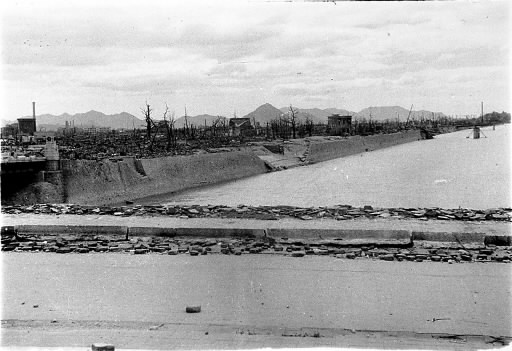My Life: Interview with Poet Hiromi Misho, Part 5
Oct. 21, 2010
A-bombed Hiroshima
by Kazunobu Ito, Staff Writer
Shock at the sight of the ruined city
I entered Okayama Medical College (now, Okayama University) in April 1945. Air raids by U.S. forces had already intensified and there was an air raid on the city of Okayama on June 29. Though classes continued to be held in classrooms that escaped the fire, I could no longer concentrate on studying. I thought that Japan would soon lose the war, as my father had told me. If I had to die, I wanted to die with my father, and so I returned to Iwakuni in Yamaguchi Prefecture. I think it was probably August 3 or 4.
On the morning of August 6, Hiromi Misho saw the flash of the atomic bomb from his home in Iwakuni.
The news that "Hiroshima has been destroyed" spread to Iwakuni by the early afternoon. I heard from my younger sister, who had been mobilized for work at the Army Fuel Depot, that "The wounded carried in by truck suffered severe burns. Many of them were already dead." I felt that something horrible had happened.
The next day, a woman who lived across the street from us said to me: "My daughter went to Hiroshima and hasn't returned. Could you go there to look for her?" As I was also worried about my friends at the former Hiroshima High School (now, Hiroshima University), I entered the city on the morning of August 8.
When I arrived at Koi station of the Japan National Railway (now, JR Nishi-Hiroshima station), I found that Hiroshima had been burned to the ground as far as the eye could see. I was shocked that I could see all the way to Ninoshima Island. As the rubble had been cleared away from the main street, I walked to the center of the city along a streetcar line. When I looked down at the river from Aioi Bridge [the original target of the atomic bomb], I saw bodies resting here and there, the bellies badly swollen. I was unable to distinguish if they were male or female. It was odd seeing smoke rising in the direction of the drill ground, but I learned later that the smoke came from bodies being cremated.
I searched for the daughter of the woman across the street from our house, studying the name tags of young women laid in rescue centers for the wounded, including Fukuya Department Store. Though I was unable to find her, I heard that she returned to Iwakuni a few days later.
As Dr. Misho made his way back to Koi station, evening was falling.
When I was standing on the train platform, I heard a burbling sound at my feet. It was the sound of blood oozing from a gash made on the chest of a half-naked man who was lying on the ground. Even if I wanted to help him, there was nothing I could do. As I stared at him, a fly emerged from the blood. I was surprised at the sight of the fly and I continued to watch it. The fly was then sucked into the man's lungs when he breathed in. Though I had seen dead bodies and people at the point of death all day, the scene came as a great shock to me: "Is this Hiroshima?" A mix of sorrow and anger threw me into a kind of despair. The figure of the young man is my last recollection of that day; after that, my memory falters.
(Originally published on July 31, 2010)







